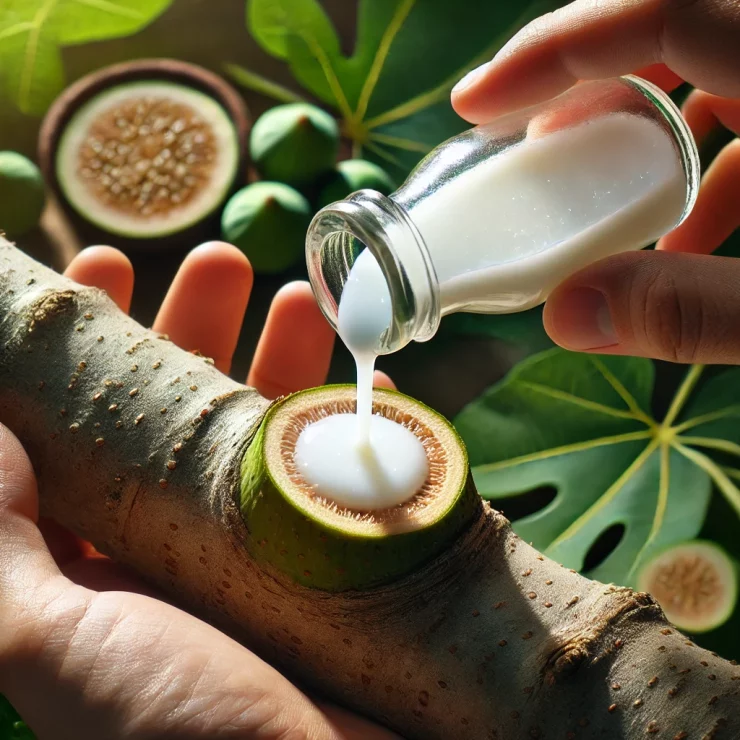Fig trees, with their lush leaves and delicious fruits, have been cultivated for thousands of years. However, there’s more to this ancient plant than meets the eye. One of the lesser-known aspects of the fig tree is its milky sap, which has been used in traditional medicine and various practical applications for centuries. If you’ve ever pruned a fig tree or harvested its fruit, you might have noticed a sticky white substance oozing from the cut or broken stems. This is the fig’s milky sap, and it’s a natural substance worth collecting. Here’s why I collect fig milky sap in a small bottle and how I use it.
What Is Fig Milky Sap?
The milky sap of a fig tree, also known as latex, is a white, sticky substance that exudes from the tree’s leaves, stems, and unripe fruit when they are cut or damaged. This sap contains a complex mixture of enzymes, proteins, and other compounds that give it unique properties. While the sap can be irritating to the skin, it has also been used traditionally for a variety of purposes due to its medicinal and practical benefits.
1.Natural Wart Remover
One of the most effective uses of fig milky sap is as a natural wart remover. The sap contains proteolytic enzymes, which help break down the proteins in the skin cells that form warts. By applying the sap directly to the wart, you can help dissolve the wart tissue over time, making it a natural and cost-effective remedy.
How to Use:
Collect the milky sap in a small bottle.
Apply a small amount of the sap directly to the wart using a cotton swab or your fingertip.
Cover the wart with a bandage and repeat the application daily until the wart shrinks and eventually disappears.
2.Treats Skin Blemishes and Acne
The same enzymes that make fig sap effective against warts can also be used to treat skin blemishes and acne. The sap helps to exfoliate dead skin cells, unclog pores, and reduce inflammation, making it a natural remedy for clear skin. However, due to its potency, it should be used sparingly and with caution to avoid skin irritation.
How to Use:
Dab a tiny amount of fig sap onto blemishes or acne spots using a cotton swab.
Leave it on for 15-20 minutes, then rinse off with warm water.
Use this treatment only once or twice a week to avoid over-irritating the skin.
3.Natural Insect Repellent
Fig milky sap can also be used as a natural insect repellent. The sticky, bitter-tasting sap deters insects from feeding on plants and can be applied to garden tools or directly to plants to protect them from pests. Its strong odor and sticky nature create an effective barrier against insects.
How to Use:
Apply a thin layer of fig sap to the stems or leaves of plants that are prone to insect attacks.
You can also smear a small amount of sap on garden tools or outdoor furniture to keep insects at bay.
4.Cleans and Disinfects Cuts and Wounds
The antibacterial properties of fig sap make it useful for cleaning and disinfecting minor cuts and wounds. The sap helps prevent infection by killing bacteria and can also promote faster healing due to its enzyme content. However, it’s important to test the sap on a small area of skin first to ensure there’s no adverse reaction.
How to Use:
Apply a small amount of fig sap directly to a minor cut or wound.
Allow the sap to dry, forming a protective barrier over the wound.
Rinse off after a few hours and reapply as needed.
5.Softens Corns and Calluses
Corns and calluses can be uncomfortable and painful, but fig sap offers a natural solution to soften and reduce these hardened areas of skin. The sap’s proteolytic enzymes break down the thickened skin, making it easier to remove.
How to Use:
Apply fig sap to the corn or callus using a cotton swab.
Cover with a bandage and leave it on for several hours or overnight.
Gently exfoliate the softened area with a pumice stone and repeat the process until the corn or callus is reduced.
6.Traditional Remedy for Digestive Issues
In some cultures, fig sap has been used as a traditional remedy for digestive issues. The enzymes in the sap are believed to aid digestion and alleviate symptoms of indigestion. However, it’s important to use caution when ingesting fig sap, as it can be toxic in large amounts and may cause irritation to the mouth and throat.
How to Use:
Consult with a healthcare provider before using fig sap internally.
If approved, mix a drop of fig sap with water or honey and consume it in small quantities to aid digestion.
7.Preserving and Storing Fig Sap
Collecting and storing fig sap requires a bit of care to ensure it remains effective and doesn’t spoil. Fig sap can dry out quickly, so it’s best to store it in an airtight container, such as a small glass bottle, and keep it in a cool, dark place.
How to Collect and Store:
Use a clean, sharp knife to make a small cut on a fig branch or unripe fruit.
Allow the sap to drip into a small bottle.
Seal the bottle tightly and store it in a cool, dark location to preserve its potency.
Fig milky sap is a versatile natural substance with a wide range of uses, from skincare to pest control and beyond. While it’s important to handle the sap with care due to its potential for skin irritation, its benefits make it a valuable addition to any natural medicine cabinet. By collecting fig sap in a small bottle, you can have a handy supply of this ancient remedy ready for use whenever you need it. Whether you’re treating warts, softening calluses, or using it as a natural insect repellent, fig sap is a powerful, all-natural tool that has been trusted for centuries.






Add comment